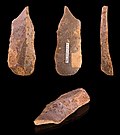In archaeology, a flake tool is a type of stone tool that was used during the Stone Age that was created by striking a flake from a prepared stone core...
5 KB (810 words) - 18:00, 23 June 2025
by the removal of flakes, is known as a core.: 254, 258 Once the proper tool stone has been selected, a percussor or pressure flaker (e.g., an antler...
10 KB (1,434 words) - 21:31, 30 March 2025
type of stone tool, a handheld lithic flake with a chisel-like edge which prehistoric humans used for carving or finishing wood or bone tools or weapons...
4 KB (435 words) - 04:49, 18 November 2024
flintknapper makes a tool from the core by reducing it to a rough unifacial or bifacial preform, which is further reduced by using soft hammer flaking or by pressure...
38 KB (4,380 words) - 18:07, 30 June 2025
Lithic reduction (redirect from Pressure flaking)
starting point may be a piece of the debitage, a flake removed from a previous operation to make a larger tool. The selected piece is called the lithic core...
23 KB (3,187 words) - 05:25, 29 April 2025
Oldowan (redirect from Pebble tool)
Pleistocene. These early tools were simple, usually made by chipping one, or a few, flakes off a stone using another stone. Oldowan tools were used during over...
65 KB (7,544 words) - 14:03, 19 June 2025
specialized stone flake tool with a sharp edge, like a small razor blade. Prismatic blades are flaked from stone cores through pressure flaking or direct percussion...
5 KB (638 words) - 14:36, 26 February 2025
Acheulean (redirect from Achulean Tools)
Some smaller tools were made from large flakes that had been struck from stone cores. These flake tools and the distinctive waste flakes produced in Acheulean...
43 KB (4,900 words) - 14:01, 28 June 2025
Uniface (section Modified flakes)
of stone tool that has been flaked on one surface only. There are two general classes of uniface tools: modified flakes and formalized tools, which display...
4 KB (494 words) - 16:50, 24 May 2024
orange flake tool was collected. In 2017, further orange debitage was found along with bison carpal and teeth fragments, and obsidian flakes, all suggesting...
5 KB (384 words) - 01:38, 25 May 2025
Clactonian (redirect from Clactonian flake)
included flint chopping tools, flint flakes and the tip of a worked wooden shaft, the Clacton Spear. Further examples of the tools have been found at sites...
10 KB (978 words) - 14:39, 23 May 2025
are "flake stone tools". Tools are the most important items that the ancient humans used to climb to the top of the food chain; by inventing tools, they...
42 KB (4,805 words) - 05:56, 23 May 2025
Americas. Archeologists and anthropologists use surviving crafted lithic flaked tools to classify cultural periods. Scientific evidence links Indigenous Americans...
59 KB (5,407 words) - 19:49, 19 June 2025
the tool. Acheulean cleavers resemble handaxes but with the pointed end truncated away. Flake cleavers have a cutting edge created by a tranchet flake being...
6 KB (761 words) - 23:25, 2 April 2025
Levallois technique (redirect from Levallois flake)
edge than the other flake-making technique under same amount of cores, and no need to worry about the lack of raw material to make tools. There is disagreement...
20 KB (2,448 words) - 09:14, 9 June 2025
the production of stone tools and weapons by knapping stone. This assemblage may include the different kinds of lithic flakes and lithic blades, but most...
13 KB (1,743 words) - 19:13, 21 July 2023
nucleus resulting from the detachment of one or more flakes from a lump of source material or tool stone, usually by using a hard hammer precursor such...
7 KB (835 words) - 14:59, 26 February 2025
Calico Early Man Site (section Flake scar angles)
currently being excavated and is yielding artifactual material. The tools and flakes of LMLI and those found in the nested inset known as the Rock Wren...
17 KB (2,179 words) - 03:19, 11 May 2025
sometimes even fly short distances carrying the bark flake in their beak. The evolutionary origin of this tool use might be related to these birds frequently...
140 KB (16,860 words) - 14:46, 30 June 2025
bifacial handaxes and cleavers, but also includes flake tools, microliths and other chopping tools. Most were made from quartzite. The Madrasian was named...
16 KB (1,879 words) - 05:30, 2 June 2025
Hand axe (section Tool stone and cortex)
the hand axe was not itself a tool, but a large lithic core from which flakes had been removed and used as tools (flake core theory). On the other hand...
105 KB (12,363 words) - 23:17, 27 June 2025
assemblages generally comprise choppers, discoids, scrapers, cores, and flake-type tools, all occurring in varying typo-technological frequencies at different...
25 KB (2,729 words) - 04:13, 25 May 2025
conclusion was that flakes themselves were the desired tool in lithic reduction, which was supported by their identification of flakes used for butchery...
17 KB (1,863 words) - 17:30, 23 May 2025
stone flake after the ventral surface has been created. It can be done to the edge of an implement in order to make it into a functional tool, or to...
9 KB (1,225 words) - 23:47, 27 October 2023
Americas. The stage derived its name from the first appearance of flaked stone tools. The term Paleo-Indian is an alternative, generally indicating much...
12 KB (1,286 words) - 21:24, 7 June 2025
site of the highest state of development of Middle Paleolithic Flake tool techniques. Tools of this era, starting about 30,000 BC, are called Aterian (after...
211 KB (20,088 words) - 06:20, 30 June 2025
have been shaped due to their use. Tool base: Scrapers are classified based on if they originated from a blade or a flake. Number of working edges: Some scrapers...
6 KB (841 words) - 13:27, 24 November 2024
a flake removed from a lithic flake's bulb of force, which is a lump left on the ventral surface of a flake after it is detached from a core of tool stone...
1 KB (146 words) - 18:53, 9 August 2019






















